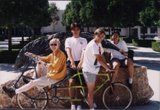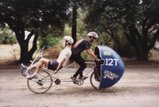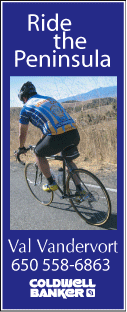It's Alive!
Well after many hard hours of work, We test rode the bike today in a parking lot (away from traffic). It held together, with a few little bugs, so I'd call it a success. Alicia was taking the photos, as you can see her shadow as we both sit on the bike. Tomorrow we will try it on the road!
I'm kind of sick of my hands being greasy every night. I've used gloves before, but this time there were just too many times where I had to remove them or they would get pinched between parts. Maybe it's a little better for the environment, or not with all the hand washing. We're both very excited to be able to ride the Double Take finally. Tomorrow will be a good indication of how my modifications worked and also how good of shape we're both in. And it's plenty of time to tweak mechanically before Napa. I can't say the same for our legs, but we'll see what happens!








